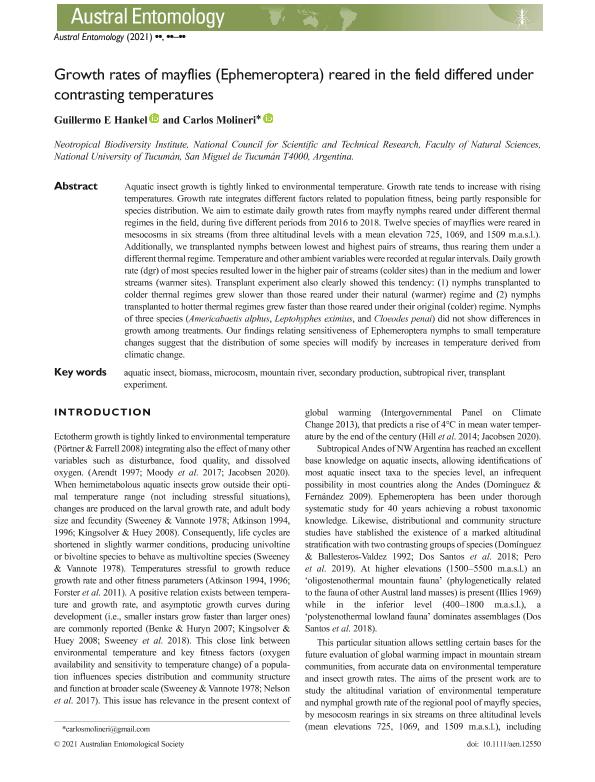Mostrar el registro sencillo del ítem
dc.contributor.author
Hankel, Guillermo Eduardo

dc.contributor.author
Molineri, Carlos

dc.date.available
2022-09-29T15:42:05Z
dc.date.issued
2021-08
dc.identifier.citation
Hankel, Guillermo Eduardo; Molineri, Carlos; Growth rates of mayflies (Ephemeroptera) reared in the field differed under contrasting temperatures; John Wiley & Sons Inc.; Austral Entomology; 60; 3; 8-2021; 578-587
dc.identifier.issn
2052-174X
dc.identifier.uri
http://hdl.handle.net/11336/171071
dc.description.abstract
Aquatic insect growth is tightly linked to environmental temperature. Growth rate tends to increase with rising temperatures. Growth rate integrates different factors related to population fitness, being partly responsible for species distribution. We aim to estimate daily growth rates from mayfly nymphs reared under different thermal regimes in the field, during five different periods from 2016 to 2018. Twelve species of mayflies were reared in mesocosms in six streams (from three altitudinal levels with a mean elevation 725, 1069, and 1509 m.a.s.l.). Additionally, we transplanted nymphs between lowest and highest pairs of streams, thus rearing them under a different thermal regime. Temperature and other ambient variables were recorded at regular intervals. Daily growth rate (dgr) of most species resulted lower in the higher pair of streams (colder sites) than in the medium and lower streams (warmer sites). Transplant experiment also clearly showed this tendency: (1) nymphs transplanted to colder thermal regimes grew slower than those reared under their natural (warmer) regime and (2) nymphs transplanted to hotter thermal regimes grew faster than those reared under their original (colder) regime. Nymphs of three species (Americabaetis alphus, Leptohyphes eximius, and Cloeodes penai) did not show differences in growth among treatments. Our findings relating sensitiveness of Ephemeroptera nymphs to small temperature changes suggest that the distribution of some species will modify by increases in temperature derived from climatic change.
dc.format
application/pdf
dc.language.iso
eng
dc.publisher
John Wiley & Sons Inc.

dc.rights
info:eu-repo/semantics/openAccess
dc.rights.uri
https://creativecommons.org/licenses/by-nc-sa/2.5/ar/
dc.subject
AQUATIC INSECT
dc.subject
BIOMASS
dc.subject
MICROCOSM
dc.subject
MOUNTAIN RIVER
dc.subject
SECONDARY PRODUCTION
dc.subject
SUBTROPICAL RIVER
dc.subject
TRANSPLANT EXPERIMENT
dc.subject.classification
Zoología, Ornitología, Entomología, Etología

dc.subject.classification
Ciencias Biológicas

dc.subject.classification
CIENCIAS NATURALES Y EXACTAS

dc.title
Growth rates of mayflies (Ephemeroptera) reared in the field differed under contrasting temperatures
dc.type
info:eu-repo/semantics/article
dc.type
info:ar-repo/semantics/artículo
dc.type
info:eu-repo/semantics/publishedVersion
dc.date.updated
2022-02-15T20:38:48Z
dc.identifier.eissn
2052-1758
dc.journal.volume
60
dc.journal.number
3
dc.journal.pagination
578-587
dc.journal.pais
Australia

dc.description.fil
Fil: Hankel, Guillermo Eduardo. Consejo Nacional de Investigaciones Científicas y Técnicas. Centro Científico Tecnológico Conicet - Tucumán. Instituto de Biodiversidad Neotropical. Universidad Nacional de Tucumán. Facultad de Ciencias Naturales e Instituto Miguel Lillo. Instituto de Biodiversidad Neotropical. Instituto de Biodiversidad Neotropical; Argentina
dc.description.fil
Fil: Molineri, Carlos. Consejo Nacional de Investigaciones Científicas y Técnicas. Centro Científico Tecnológico Conicet - Tucumán. Instituto de Biodiversidad Neotropical. Universidad Nacional de Tucumán. Facultad de Ciencias Naturales e Instituto Miguel Lillo. Instituto de Biodiversidad Neotropical. Instituto de Biodiversidad Neotropical; Argentina
dc.journal.title
Austral Entomology
dc.relation.alternativeid
info:eu-repo/semantics/altIdentifier/doi/http://dx.doi.org/10.1111/aen.12550
dc.relation.alternativeid
info:eu-repo/semantics/altIdentifier/url/https://onlinelibrary.wiley.com/doi/10.1111/aen.12550
Archivos asociados
